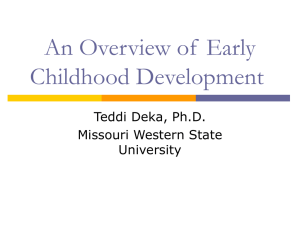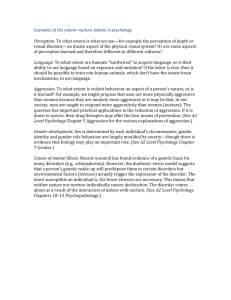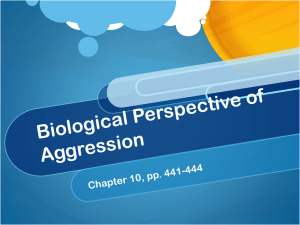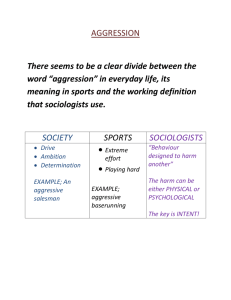File - the Durham School Psychology Department!
advertisement
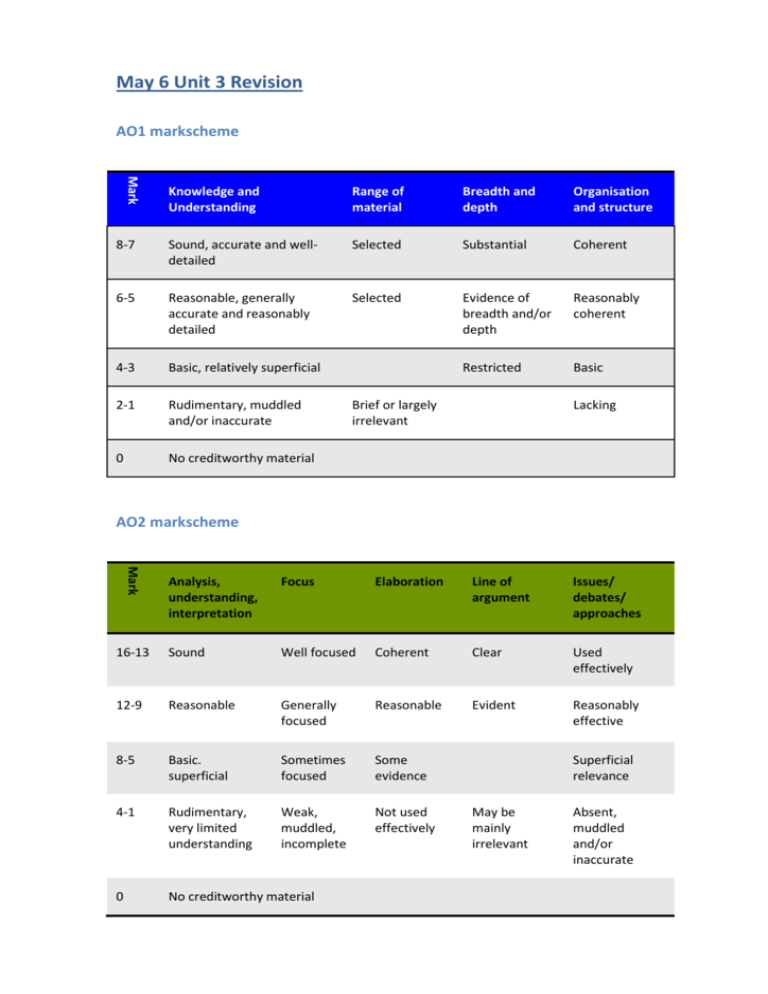
May 6 Unit 3 Revision AO1 markscheme Mark Knowledge and Understanding Range of material Breadth and depth Organisation and structure 8-7 Sound, accurate and welldetailed Selected Substantial Coherent 6-5 Reasonable, generally accurate and reasonably detailed Selected Evidence of breadth and/or depth Reasonably coherent 4-3 Basic, relatively superficial Restricted Basic 2-1 Rudimentary, muddled and/or inaccurate 0 No creditworthy material Brief or largely irrelevant Lacking AO2 markscheme Mark Analysis, understanding, interpretation Focus Elaboration Line of argument Issues/ debates/ approaches 16-13 Sound Well focused Coherent Clear Used effectively 12-9 Reasonable Generally focused Reasonable Evident Reasonably effective 8-5 Basic. superficial Sometimes focused Some evidence 4-1 Rudimentary, very limited understanding Weak, muddled, incomplete Not used effectively 0 No creditworthy material Superficial relevance May be mainly irrelevant Absent, muddled and/or inaccurate May 6 Session 1: AO1 Skills Document 1 (slide 7) Outline and evaluate psychological explanations for the success and/or failure of dieting. (8 marks + 16 marks) There are many different types of dieting, the definition ‘restricting oneself to smaller amounts of certain kinds of foods’. The restraint theory was developed to investigate the causes and consequences of dieting. The theory suggests that for some individuals dieting can be successful with weight loss as a result of undereating. On the other had, it can also be unsuccessful resulting in overeating and weight gain. There are many different pressures for individuals to lose weight such as family, social class, peer groups, ethnicity and the media. The media plays a big role as to why some people feel the need to lose weight. There is a certain level of individuals observing and imitating celebrities. This is because of positive reinforcement which comes from fame and money and punishment is seen through bad publicity. Therefore there is more attraction for the individual to be like celebrities and ‘skinny’. There are three main categories which are effective in losing weight these being calorie control diets, behavioural therapy and healthy eating. There are different types of dieting available such as surgery, drugs, external monitoring (such as keeping food diaries) and low calorie diets. Wilenbring et al (1986) carried out a laboratory study on humans which they found that research participants ate less during periods of stress. This study is easy to apply to the target population as it was carried out on humans. There is also ease of replication, however it lacks mundane realism because it was carried out in a laboratory. Many studies have been carried out as to the successfulness of dieting. Rodin (1977) found that central to dieting success was individuals’ belief about the cause of their obesity and their motivation for change. Kiernan (1998) carried out a study which found that people who were most dissatisfied with their bodies prior to dieting were more likely to succeed in their dieting attempts. Ogden and Hills interviewed people who had successfully lost weight and maintained weight loss. It was found that a life event such as a milestone, illness or divorce had an effect on their eating style. Therefore research shows that it is four main factors that help increase the successfulness of dieting, this being motivation, individual belief, dissatisfaction with their body and life events. Dieting is not always successful and can often fail. Davey suggested that stress is directly related to overeating. This suggestion is subjective as individual differences are not taken into account. A dramatic restriction on calorie intake over a short period of time is ineffective, therefore people who diet by just reducing their calorie intake are not actually successful in their dieting. Research has suggested that a reason for why diets fail can be due to a negative mood , dieters tend to overeat in response to their low mood. Another reason for why diets fail could be due to the fact that today there is greater availability of food choices, combining this with an evolutionary tendency to store fat has contributed to weight gain. External eaters will eat for other reasons rather than just when they are hungry, restrained eaters are careful about their diets and watch the calorie intake therefore when put under stress could eat a lot more and emotional eaters eat what they want and when they want depending on their mood. These are all examples of diets failing, it is due to vulnerability. Studies have been carried out on unsuccessful diets and assess the reasons why. Herman and Mack (1975) took a sample of dieters and non dieters. They were then given a high or low calorie pre-load and then a high calorie load. It was found that the dieters who ate high calories in the preload stage continue to eat in the loading stage, whereas non-dieters continued to binge because they were psychologically hungry. Therefore the study suggests that dieting can lead to overeating and excess calorie intake. Although the study had ease of replication, the study had low ecological validity and mundane realism as it is unlikely that individuals would be put in a situation like this in real life. Another study was carried out by Wardle and Beales (1988) to investigate whether dieting results in overeating. They randomly assigned 27 obese women to a group, either a diet group, exercise group or a control group. It was found that the participants in the diet group ate more. They concluded that attempting to diet can increase the desire to overeat. Due to small samples of 27 women it is hard to generalise as it was found that 70% of women diet in a lifestyle. 765 words Document 2 (slide 13) Outline one or more social psychological theories of aggression. (8 marks Bandura proposes that aggression can be learned through observational learning of relevant role models. Social learning theory states children also learn aggressive behaviours through vicarious reinforcement, whereby they may witness relevant/pertinent role models being punished/rewarded for a specific behaviour. Behaviour that is punished leads to being ignored, whilst behaviour that is rewarded tends to be imitated. The concept of self-efficacy is also relevant to this social theory of aggression which takes into account the capability of the individual being able to carry out aggressive behaviour they aim to imitate. The likelihood of an aggressive behaviour being imitated depends on the relevance of the role model to the individual, whether the role model has aspirational qualities, if the individual has low selfesteem and how dependent the individual is on others. 129 words May 6 Session 3: Putting it together Document 1 (slide 5) Discuss the influence of childhood on adult relationships. (8 marks + 16 marks) The continuity hypothesis suggests that an individual’s relationship with their primary caregiver provides foundation for adult relationships by creating an internal working model (IWM). The IWM influences a person’s expectation of later relationships thus affects his attitudes towards them. Adult relationships are likely to reflect early attachment style. This is because the experience a person has with their caregiver in childhood would lead to the expectation of the same experiences in later relationships. This is illustrated in Hazan and Shaver’s love quiz experiment. They conducted a study to collect information of participants’ early attachment styles and their attitudes towards loving relationships. They found that those who were securely attached as infants tended to have happy lasting relationships. On the other hand, insecurely attached people found adult relationships more difficult, tended to divorce and believed love was rare. This supports the idea that childhood experiences have significant impact on people’s attitude toward later relationships. However, the association made by Hazan and Shaver might not be reliable because of the use of a questionnaire . Although this method can provide quantitative and qualitative data participants might answer in a biased way to be more socially desirable, which is called social desirability bias. Moreover, the data might be retrospective since participants had to recall experience from early childhood which can be inaccurate thus reducing the reliability of the findings. Another methodological flaw of this study is the sample bias. The questionnaire was posted in an American newspaper and people volunteered to answer. This can raise the problem of individual differences, for example people who volunteer tend to be more socially outgoing or have more free time. Therefore the finding cannot be applied to the whole population due to low generalisability. There is difficulty in investigating the role of childhood experiences in adult relationships due to the concerns of stability of attachment styles. Securely attached children can become insecurely attached due to life events. This suggests that the influence of early childhood on later relationships can be varied. This theory is accused of being reductionist because it assumes that people who are insecurely attached as infants would have poor quality relationships. This is not always the case. Researchers found plenty of people having happy relationships despite having insecure attachments. Therefore the theory might be an oversimplification. Nevertheless supporting evidence comes from Simpson who did a longitudinal study on participants from their early childhood to their twenties. They found that securely attached children tend to grow up to be more socially competent and develop secure friendships and have happy relationships. Peer relationships in this period also have an important influence on how people approach adult relationships. Children develop a sense of their own values and others based on specific experiences which then become internalised and affect the way they behave in adult relationships. Nangle supports this by highlighting the importance of having a friend to trust which creates a sense of being loved and understood. These characteristics are important in adult relationships. There are gender differences in the early friendship with peers. Boys tend to have more competitive friendships while girls are more cooperative and sharing activities. This suggests that the influence of early childhood peers interaction can be different for males and females. However Erwin argues that sex differences have been over emphasised and many similarities have been overlooked. Adolescence is a critical period marked by the increasing importance of friendship and the emergence of romantic relationships. Social learning theory suggests that parents can transfer their idea about opposite sex to their children by the process of modelling. Gray reported how adolescents who were raised in caring warm families are better prepared for adult relationships. Friendships at this stage are more important because friends provide a secure base for independent exploration to the adult world. Romantic relationships in this period allow individuals to develop physical and emotional intimacy which then affects adolescence and attitudes to adult relationships. Marsden claims that although romantic relationships have positive benefit, too much dating can have negative consequences. This is supported by Neuman who concluded that romantic dating in teenagers is linked to low academic achievement and antisocial behaviour. One criticism for this is cultural bias , if the social context affects adolescent’s dating then the studies which are based on small sample size cannot be applied universally. 718 words Document 2 (slide 9) Discuss the role of neural and/or hormonal mechanisms in aggression. (8 marks + 16 marks) When looking at neural mechanisms in aggression consideration must be applied to the nature/nurture debate, as the particular theory applies to the nature debate. When thinking of neural theories this is the method of the brain which links to the idea of inheritance as well as to what we are exposed to in the womb, effecting our development. A main gene that is to do with aggression is the MAOA gene. Levels of this gene determine our aggression. In one animal study by Skinner (1974) mice were implanted with the MAOA gene. The female mice who were given this gene became much more aggressive compared to those without the gene. This highlights the issue of generalisation, as you can’t really generalise this study to humans. Furthermore the issue of the animal debate arises as animal rights may not have been part of this study. Also Brunner (1993) did a relevant study. He investigated 40 Dutch families where the father had a violent criminal conviction. He found that the fathers had abnormal levels of the MAOA gene. However this study lacks cultural validity as it was just conducted in one country. Furthermore it lacks historical validity due to the dated research. However the same does show some generalisability. Furthermore the study highlights debates such as free will and determinism, as it highlights whether they were determined by the genetics. Moving on to the second topic relevant to neural aggression. In the male genitalia there are the testes which produce testosterone. Testosterone is believed to be linked to aggression, the higher the levels of testosterone the higher the levels of aggression. When looking at the definition of aggression it is the act or series of acts with the intent to harm something or someone (Cardwell) its important to look at the reasoning behind it. Many studies have been conducted to try to prove this correlational link between testosterone and aggression. For example Quadrago (1977) did an animal study which involved purposefully exposing young female apes to high levels of testosterone. This resulted in them displaying frequent rough and tumble play. However this study can’t be generalised to humans. Furthermore due to the date of the study it also lacks historical validity. On the other hand it shows strong evidence for the link between aggression and testosterone as high levels of testosterone are usually associated with males whether this is gender bias or simply social constructionism. Furthermore when looking into human studies a popular area of research comes from sport. In 1998 Condry conducted a study on a group of males who were watching a sports game while measuring their testosterone levels. They found that if their team was losing, the males had increasing testosterone followed by aggressive tendencies such as swearing and making aggressive gestures. This study is fairly realistic so it has substantial ecological validity. It also highlights the issue of reductionism as the males being aggressive through younger socialisation and modeling or they are naturally going to be aggressive. Also the study may be seen as gender biased due to the all male sample. An interesting study which strongly supports the nature side of the debate comes from Ehrhardt (2002) found that children who had been adopted and had criminal convictions had biological fathers with criminal convictions. This strongly supports the idea that aggression is inherited and a part of our genes. But on the other hand this theory ignores environmental factors such as peer pressure or difficult home life. Which makes the theory reductionist by ignoring social constructionsim. Also the theory is fairly gender biased as a high number of studies are all males or specifically look into male aggression. 611 words
